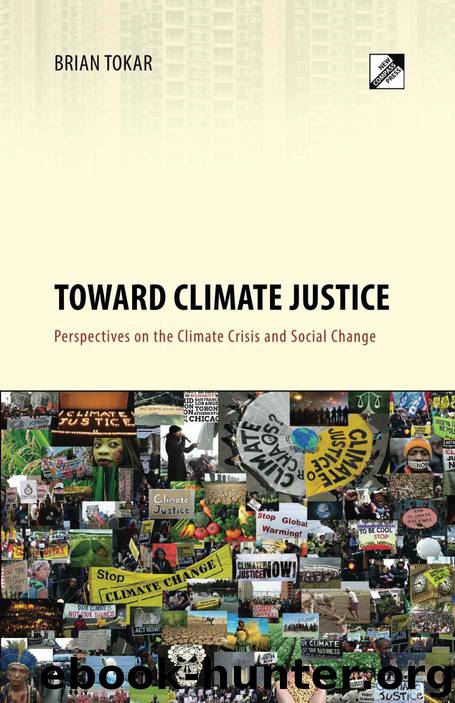Toward Climate Justice: Perspectives on the Climate Crisis and Social Change by Brian Tokar

Author:Brian Tokar [Tokar, Brian]
Language: eng
Format: epub
Publisher: New Compass Press
Published: 2014-09-23T00:00:00+00:00
Trading Pollution
The notion that new commodity markets can become a tool for reducing global emissions of greenhouse gases is perhaps the most brazen expression of capitalist ideology in the climate debate. When Al Gore—then US Vice President—addressed the UN climate conference in Kyoto in 1997, he offered, as we have seen, that the US would sign on to what soon became the Kyoto Protocol under two conditions: that mandated reductions in emissions be far less ambitious than originally proposed, and that emissions reductions be implemented through the market-based trading of “rights to pollute” among various companies and between countries. Under this “cap-and-trade” model, companies are expected to meet a quota for “capping” their emissions; if they fail to do so, they can readily purchase the difference from another permit holder that may have found a way to reduce its emissions faster or more cheaply. While economists claim that this scheme induces companies to implement the most cost-effective changes as soon as possible, experience shows that carbon markets are at least as prone to fraud and manipulation as any other financial markets. More than fifteen years after the Kyoto Protocol was signed, many industrialized countries were still struggling to bring down their annual rate of increase in global warming pollution.18
The ideological roots of carbon trading go back to the early 1960s, when corporate managers were just beginning to consider the consequences of pollution and resource depletion.19 Chicago School economist R. H. Coase published a key paper in 1960, where he challenged the widely accepted view of pollution as an economic “externality”—an approach that originated in the 1920s—and proposed a direct equivalence between the harm caused by pollution and the economic loss to polluting entities if they are compelled to curtail production. “The right to do something which has a harmful effect,” argued Coase, “is also a factor of production.”20 He proposed that steps to regulate production be evaluated on par with the value of the market transactions that those regulations aim to alter, arguing that economics should determine the optimal allocation of resources needed to best satisfy all parties to any dispute.
The Canadian economist J.H. Dales, widely acknowledged as the founder of pollution trading, carried the discussion two steps further. First, he echoed the neoclassical view that charging for pollution, via a disposal fee or tax, is more efficient than either regulation or subsidizing alternative technologies. Then, as an extension of this argument, Dales proposed a “market in pollution rights” as an administratively simpler and less costly means of implementing pollution charges. “The pollution rights scheme, it seems clear, would require far less policing than any of the others we have discussed,” Dales suggested—a proposition thoroughly at odds with the world’s experience since Kyoto.21 In 1972, California Institute of Technology economist David Montgomery presented a detailed mathematical model, purporting to show that a market in licenses to pollute indeed reaches a point of equilibrium at which desired levels of environmental quality are achieved at the lowest possible cost.22
By the mid-1970s, the
Download
This site does not store any files on its server. We only index and link to content provided by other sites. Please contact the content providers to delete copyright contents if any and email us, we'll remove relevant links or contents immediately.
The Secret History by Donna Tartt(16627)
The Social Justice Warrior Handbook by Lisa De Pasquale(11489)
Thirteen Reasons Why by Jay Asher(7788)
This Is How You Lose Her by Junot Diaz(5775)
Weapons of Math Destruction by Cathy O'Neil(5038)
Zero to One by Peter Thiel(4824)
The Myth of the Strong Leader by Archie Brown(4789)
Promise Me, Dad by Joe Biden(4449)
Beartown by Fredrik Backman(4420)
Stone's Rules by Roger Stone(4417)
How Democracies Die by Steven Levitsky & Daniel Ziblatt(4399)
The Fire Next Time by James Baldwin(4343)
100 Deadly Skills by Clint Emerson(4079)
A Higher Loyalty: Truth, Lies, and Leadership by James Comey(4033)
Rise and Kill First by Ronen Bergman(4012)
The David Icke Guide to the Global Conspiracy (and how to end it) by David Icke(3883)
The Farm by Tom Rob Smith(3872)
Secrecy World by Jake Bernstein(3783)
The Doomsday Machine by Daniel Ellsberg(3732)
